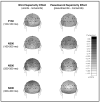Word and pseudoword superiority effects reflected in the ERP waveform
- PMID: 20211607
- PMCID: PMC2857552
- DOI: 10.1016/j.brainres.2010.02.084
Word and pseudoword superiority effects reflected in the ERP waveform
Abstract
A variant of the Reicher-Wheeler task was used to determine when in the event-related potential (ERP) waveform indices of word and pseudoword superiority effects might be present, and whether ERP measures of superiority effects correlated with standardized behavioral measures of orthographic fluency and single word reading. ERPs were recorded to briefly presented, masked letter strings that included real words (DARK/PARK), pseudowords (DARL/PARL), nonwords (RDKA/RPKA), and letter-in-xs (DXXX, PXXX) stimuli. Participants decided which of two letters occurred at a given position in the string (here, forced-choice alternatives D and P). Behaviorally, both word (more accurate choices for letters in words than in baseline nonwords or letter-in-xs) and pseudoword (more accurate choices for letters in pseudowords than in baseline conditions) superiority effects were observed. Electrophysiologically, effects of orthographic regularity and familiarity were apparent as early as the P150 time window (100-160ms), an effect of lexicality was observed as early as the N200 time window (160-200ms), and peak amplitude of the N300 and N400 also differentiated word and pseudoword as compared to baseline stimuli. Further, the size of the P150 and N400 ERP word superiority effects was related to standardized behavioral measures of fluency and reading. Results suggest that orthographic fluency is reflected in both lower-level, sublexical, perceptual processing and higher-level, lexical processing in fluently reading adults.
Copyright 2010 Elsevier B.V. All rights reserved.
Figures






Similar articles
-
Behavioral and ERP evidence of word and pseudoword superiority effects in 7- and 11-year-olds.Brain Res. 2012 Nov 27;1486:68-81. doi: 10.1016/j.brainres.2012.09.041. Epub 2012 Oct 1. Brain Res. 2012. PMID: 23036274 Free PMC article. Clinical Trial.
-
The speed of orthographic processing during lexical decision: electrophysiological evidence for independent coding of letter identity and letter position in visual word recognition.J Cogn Neurosci. 2008 Jul;20(7):1283-99. doi: 10.1162/jocn.2008.20088. J Cogn Neurosci. 2008. PMID: 18284349
-
Word processing deficits in children with isolated and combined reading and spelling deficits: An ERP-study.Brain Res. 2020 Jul 1;1738:146811. doi: 10.1016/j.brainres.2020.146811. Epub 2020 Mar 29. Brain Res. 2020. PMID: 32234513
-
Word and pseudoword superiority effects: Evidence from a shallow orthography language.Q J Exp Psychol (Hove). 2018 Sep;71(9):1911-1920. doi: 10.1080/17470218.2017.1363791. Epub 2018 Jan 1. Q J Exp Psychol (Hove). 2018. PMID: 28770652
-
From sublexical facilitation to lexical competition: ERP effects of masked neighbor priming.Brain Res. 2018 Apr 15;1685:29-41. doi: 10.1016/j.brainres.2018.01.029. Epub 2018 Jan 31. Brain Res. 2018. PMID: 29407530 Free PMC article.
Cited by
-
Event-related potential and lexical decision task in dyslexic adults: Lexical and lateralization effects.Front Psychol. 2022 Nov 9;13:852219. doi: 10.3389/fpsyg.2022.852219. eCollection 2022. Front Psychol. 2022. PMID: 36438365 Free PMC article.
-
Lexical and sublexical cortical tuning for print revealed by Steady-State Visual Evoked Potentials (SSVEPs) in early readers.Dev Sci. 2023 Jul;26(4):e13352. doi: 10.1111/desc.13352. Epub 2022 Dec 8. Dev Sci. 2023. PMID: 36413170 Free PMC article.
-
The Electrophysiology of Basic Phrase Building.PLoS One. 2016 Oct 6;11(10):e0158446. doi: 10.1371/journal.pone.0158446. eCollection 2016. PLoS One. 2016. PMID: 27711111 Free PMC article.
-
Language context modulates reading route: an electrical neuroimaging study.Front Hum Neurosci. 2014 Feb 20;8:83. doi: 10.3389/fnhum.2014.00083. eCollection 2014. Front Hum Neurosci. 2014. PMID: 24600377 Free PMC article.
-
Neural activity tied to reading predicts individual differences in extended-text comprehension.Front Hum Neurosci. 2013 Nov 6;7:655. doi: 10.3389/fnhum.2013.00655. eCollection 2013. Front Hum Neurosci. 2013. PMID: 24223540 Free PMC article.
References
-
- Adams MJ. Models of word recognition. Cognitive Psychology. 1979;11:133–176.
-
- Adams MJ. Beginning to read: Thinking and learning about print. MIT Press; Cambridge: 1990.
-
- Bentin S, McCarthy G, Wood CC. Event-related potentials, lexical decision and semantic priming. Electroencephalography and clinical Neurophysiology. 1985;60:343–355. - PubMed
-
- Bentin S. Event-related potentials, semantic processes, and expectancy factors in word recognition. Brain and Language. 1987;31:308–327. - PubMed
-
- Bentin S, Mouchetant-Rostaing Y, Giard MH, Echallier JF, Pernier J. ERP manifestations of processing printed words at different psycholinguistic levels: time course and scalp distribution. Journal of Cognitive Neuroscience. 1999;11:235–260. - PubMed
Publication types
MeSH terms
Grants and funding
LinkOut - more resources
Full Text Sources

